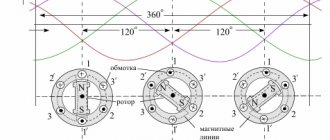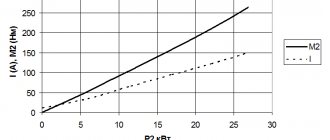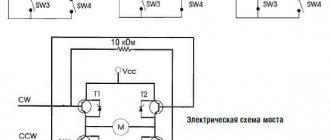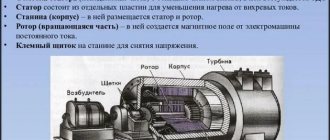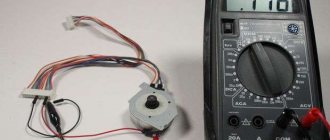Background.
Jacobi Boris Semenovich
Already in 1821, the famous British scientist Michael Faraday demonstrated the principle of converting electrical energy into mechanical energy by an electromagnetic field. The installation consisted of a suspended wire, which was dipped in mercury. The magnet was installed in the middle of the flask with mercury. When the circuit was closed, the wire began to rotate around the magnet, demonstrating that there was electricity around the wire. current, an electric field was formed.
This engine model was often demonstrated in schools and universities. This motor is considered the simplest type of the entire class of electric motors. Subsequently, it received a continuation in the form of the Barlov Wheel. However, the new device was only of a demonstration nature, since the power it generated was too small.
Scientists and inventors worked on the engine with the goal of using it for industrial needs. All of them sought to ensure that the engine core moved in a magnetic field in a rotational-translational manner, in the manner of a piston in the cylinder of a steam engine. Russian inventor B.S. Jacobi made everything much simpler. The principle of operation of its engine was the alternating attraction and repulsion of electromagnets. Some of the electromagnets were powered from a galvanic battery, and the direction of current flow in them did not change, while the other part was connected to the battery through a commutator, thanks to which the direction of current flow changed after each revolution. The polarity of the electromagnets changed, and each of the moving electromagnets was either attracted or repelled from the corresponding stationary electromagnet. The shaft began to move.
Login to the site
The study of documentary materials shows that in 1887-1889. multiphase systems have been developed with greater or lesser success by several scientists and engineers.For example, in America, Charles Bradley, trying to make an electric machine with the best use of active materials, designed two- and three-phase generators. However, Bradley was not aware of the phenomenon of a rotating magnetic field and assumed that consumers in multiphase systems should be connected as single-phase for each pair of wires.
The German engineer F. Haselwander approached the three-phase current system from other starting positions. Knowing that the commutator of the generator and the DC motor performs reciprocal functions, he decided to eliminate it, believing that it was enough to connect those points of the armature windings of each machine, from which taps go to the commutator plates, respectively, to each other.
This is convenient to do with reversed machines, the armatures of which are stationary and the poles rotate. Then the generator will be connected to the engine by a number of wires equal to the number of collector plates. In an effort to reduce the number of line wires, Haselvander found a minimum option - three wires. However, he was unable to see all the possibilities of the new system and create machine designs suitable for practice.
The greatest success in the development of multiphase systems was achieved by M. O. Dolivo-Dobrovolsky, who managed to give his work a practical character. Therefore, he is rightfully considered the founder of the technology of three-phase systems.
Mikhail Osipovich Dolivo-Dobrovolsky (1862-1919) was born in the suburbs of St. Petersburg, in the city of Gatchina, and graduated from a real school in Odessa, where his father published the local newspaper Pravda. From 1878, he studied at the Riga Polytechnic Institute, but he was unable to complete his studies, since he was expelled for participating in student unrest in the year of the regicide.
He completed his education in Germany, at the Higher Technical School of Darmstadt, where much attention was paid to the practical applications of electricity. In these favorable conditions, Dolivo-Dobrovolsky’s natural talent, hard work and inventive talent helped him quickly become one of the best students, and in 1884, after successfully graduating from the school, he was retained there as an assistant. The leadership of the department, who highly appreciated his erudition, entrusted him with teaching a new independent course on the practical application of electrochemistry.
Soon events occurred that turned out to be happy for the young teacher: he was attracted by the energetic entrepreneur Emil Rathenau, who headed the AEG (General Electricity Company) company, which had just bought off the Edison company and became independent.
The Russian engineer took the position of chief electrician of the company. In the fall of 1888, Dolivo-Dobrovolsky read Ferraris’ report on a rotating magnetic field and was extremely surprised by his conclusion about the practical unsuitability of an induction electric motor.
Even before this, Dolivo-Dobrovolsky noticed that if the armature winding of a DC motor is short-circuited when it is braking (i.e., in a dynamic braking experiment), then a large braking torque arises.
“I immediately told myself,” Veps later wrote Dolivo-Dobrovolsky, “that if you make a rotating field according to the Ferraris method and place a short-circuited low-resistance armature in it, then this armature would rather burn itself out than rotate with a small number of revolutions. In my mind I immediately imagined a multiphase current electric motor with negligible slip.”
So Dolivo-Dobrovolsky came to the conclusion that it was inappropriate to manufacture a rotor winding with such a high resistance that the rotor would have a slip of about 50%. In the rods of the low-resistance winding, with a slight slip, currents will arise, which, in a sufficiently strong stator field, will create a significant torque.
Intensified activity in this direction in an unusually short time led to the development of a three-phase electrical system and a perfect, in principle unchanged, design of an asynchronous electric motor.
The first important step that Dolivo-Dobrovolsky took was the invention of a rotor with a winding in the form of a squirrel cage. To reduce the resistance of the rotor winding, the best design solution could be a rotor in the form of a copper lindrum, as in the Ferraris engine. But copper is a poor conductor for the stator's magnetic field, and the efficiency of such a motor would be very low.
If the copper cylinder is replaced by a steel one, then the magnetic flux increases sharply, but at the same time the electrical conductivity of steel is less than that of copper. The way out of this contradiction was to make the rotor in the form of a steel cylinder (which reduced the magnetic resistance of the rotor) and insert copper rods into the channels drilled along the periphery of the latter (which reduced the electrical resistance of the rotor). On the frontal parts of the rotor, these rods must be well connected to each other.
Dolivo-Dobrovolsky's next step was to replace the two-phase system with a three-phase one. He quite rightly noted that with an increase in pure phases, the distribution of the magnetizing force around the circumference of the stator of an asynchronous motor and the use of the machine improves.
Already the transition from a two-phase system to a three-phase system provides a significant gain in this regard. A further increase in the number of phases is inappropriate, since it would lead to a significant increase in copper consumption for wires. Other advantages of the three-phase system soon became clear.
But what is the easiest way to get a three-phase system? There was already a known method by which an ordinary direct current machine could be converted into an alternating current generator. P. N. Yablochkov and Z. Gram back in the late 70s sectioned the ring armature of the generator and received alternating current from each section.
In the mid-1980s, the first rotating single-armature converters were built. These converters were very simply obtained from an ordinary direct current machine: taps were made from two points of the armature winding of a two-pole machine, which were brought out onto slip rings. In this case, direct current was supplied to the machine's collector, and alternating current was removed from the rings. If in the same armature of a DC machine we make taps from four equally spaced points, then it is easy to obtain a two-phase current system on four rings.
Tesla built a synchronous generator that had three independent coils located at an angle of 60 degrees to each other. Such a generator produced a three-phase system of currents, but required six wires to transmit energy, since in this case an unconnected three-phase circuit was obtained with currents shifted from each other in phase by 60 degrees.
Dolivo-Dobrovolsky, as a result of researching various winding circuits, made branches from three equally spaced armature points of DC machines. Thus, the currents were trained: with a phase difference of 120 degrees. By keeping the collector in this machine, it was possible to use it as a single-armature converter.
In this way, a connected three-phase system was found, which has the peculiarity that it requires only three wires for the transmission and distribution of electricity. In Tesla's two-phase system, it was also possible to make do with three wires, but the advantages of a symmetrical coupled three-phase circuit were reinforced by other advantages of both the motors and the three-phase system in general. The latter is symmetrical, balanced and economical.
Three wires in a three-phase system required 25% less metal to transmit the same power than two wires in a single-phase system. This obvious saving of metal was one of the main arguments in favor of a three-phase system. A further increase in the number of phases would lead to some improvement in the use of electrical machines, but would cause a corresponding increase in the number of linear conductors. Thus, a three-phase electric current system is an optimal multiphase system.
Dolivo-Dobrovolsky gave the system of three “conjugate” currents the special name “Drehstrora”, which translated into Russian means “rotating current”. This term, which well characterizes the ability to form a rotating magnetic field, has been preserved to this day in German literature.
In the spring of 1889, the first three-phase asynchronous motor with a power of about 100 W was built. This motor was powered by a three-phase single-armature converter and during testing showed quite satisfactory results.
Following the first single-armature converter, a second, more powerful one was created, and then the production of three-phase synchronous generators began. Already in the first generators, two main methods of connecting windings were used: star and delta. Subsequently, Dolivo-Dobrovolsky was able to improve the use of the stator using the currently widely used method, which consists in making the winding split and connecting the opposing coils in opposite directions.
An important achievement of Dolivo-Dobrovolsky was also that he abandoned the design of the motor with salient poles and made the stator winding distributed over its entire circumference, due to which magnetic scattering was significantly reduced compared to Tesla motors. Thus, a three-phase asynchronous motor with a squirrel-cage rotor received temporary structural forms.
Soon Dolivo-Dobrovolsky made another improvement: the ring winding of the stator was replaced by a drum winding. After this, the squirrel-cage asynchronous motor acquired a modern look.
A new difficulty in the development of three-phase technology arose due to the limited power of the first energy sources, both individual generators and power plants as a whole. The fact is that the starting current of an asynchronous motor with a squirrel-cage rotor can be several times higher than the rated one, and therefore the inclusion of motors with a power of over 2-3 kW has already affected the operation of other consumers.
M. O. Dolivo-Dobrovolsky in 1890 manufactured an engine with a squirrel-cage rotor with a power of approximately 3.7 kW and, at the very first test, established a significant deterioration in starting properties. The reason for this was that the squirrel cage rotor was "too shorted".
As the rotor winding resistance increased, starting conditions improved noticeably, but engine performance deteriorated. Analysis of the difficulties that arose led to the creation of the so-called phase rotor, that is, one whose winding is made, like a stator winding, three-phase and the ends of which are connected to three rings mounted on a shaft. Using brushes, these rings are connected to the starting rheostat.
Thus, at the moment of start-up, a large resistance is included in the rotor circuit, which is removed as the rotation speed increases. But the wound rotor required the installation of slip rings on the shaft, and this was considered by many industrial engineers as a disadvantage compared to a squirrel-cage rotor. However, this drawback can be reconciled, and, despite the fact that various measures were subsequently developed to improve the starting conditions of large induction motors with a squirrel-cage rotor, motors with slip rings are used in industry to this day.
Dolivo-Dobrovolsky's articles and reports contain many discussions about the inadmissibility of concentrated windings in alternating current machines, about pulsations of the magnetizing force, and about increased magnetic scattering, which worsens starting conditions. There is evidence of the formation of elements of the theory of asynchronous machines.
The structural forms of the engines created by Dolivo-Dobrovolsky were so perfect that they did not undergo any significant changes over the 100 years of their existence. In 1911, Dolivo-Dobrorolsky wrote an article “From the history of three-phase current,” where, in particular, Fr.
And in another article, he pointed out that “... the technical priority of the inventor or company that managed to make its discovery viable and, based on its idea and experience, create an applicable technical unit will remain undisputed. The merit of the practical development and technical implementation of the multiphase current system certainly belongs to AEG, which should not reduce the scientific value of the discoveries of Prof. Ferraris and Tesla."
The three-phase system would not have become rapidly widespread in the first years of its existence if it had not solved the problems of transmitting energy over long distances. But power transmission is beneficial at high voltage, which in the case of alternating current is obtained using a transformer.
The three-phase system did not present any fundamental difficulties for energy transformation, but required three single-phase transformers instead of one with a single-phase system. Such an increase in the number of rather expensive devices could not have aroused the desire to find a more satisfactory solution.
In 1889, Dolivo-Dobrovolsky invented a three-phase transformer. At first it was a transformer with radial cores. The Ero design is still reminiscent of a salient pole machine, in which the air gap is eliminated and the rotor windings are transferred to the rods.
Then several designs of so-called “prismatic” transformers were proposed, in which it was possible to obtain a more compact form of the magnetic circuit. Finally, in October 1891, a patent application was made for a three-phase transformer with parallel bars located in the same plane. In principle, this design has been preserved to the present day.
Work related to the study of three-phase circuit diagrams also met the goals of power transmission. In the 80-90s of the last century, a significant place in power consumption was occupied by the lighting load, which often introduced significant asymmetry into the system.
In addition, sometimes it was desirable to have at one’s disposal not one, but two voltages: one for the lighting load, the other, higher, for the power load. In order to be able to regulate the voltage in individual phases and have two voltages in the system (phase and linear), Dolivo-Dobrovolsky developed in 1890 a four-wire circuit for a three-phase circuit, or, in other words, a system with a neutral wire. At the same time, he indicated that instead of a neutral, or zero, wire, ground could be used.
Dolivo-Dobrovolsky justified his proposals by proving that a four-wire three-phase system allows for a certain load asymmetry; in this case, the voltage at the terminals of each phase will remain unchanged. To regulate the voltage in individual phases of a four-wire system, Dolizo-Dobrovolskin proposed using a three-phase autotransformer he invented.
Thus, within 2-3 years, all the main elements of a three-phase power supply system were structurally developed: a transformer, three-wire and four-wire transmission lines and an asynchronous motor in its two main modifications (with phase and squirrel-cage rotor).
Of all the possible designs of multiphase synchronous generators, the construction principle of which was already known long before, only three-phase machines have received wide practical application.
This is how the three-phase electric current system was born and received its initial development. A study of the history of three-phase circuit technology shows that the decisive role in its origin and development was played by the works of M. and O. Dolivo-Dobrovolsky. He not only developed the basic elements of a three-phase system, but also made a number of important inventions in the field of direct current technology and electrical measuring technology; He also owns some other works.
Undoubtedly, such a rapid and complete success of the works of M. O. Dolivo-Dobrovolsky is largely determined by the fact that they met the basic needs of practice. The main direction of Dolivo-Dobrovolsky’s work coincided with the main direction in the development of the electric power industry.
In addition, one should not lose sight of the fact that Dolivo-Dobrovolsky worked in the conditions of the most developed German electrical industry at that time and, being one of the technical managers of the largest electrical engineering company, had great opportunities for experimental research and practical implementation of his inventions.
In 1914, when the First World War broke out, Dolivo-Dobrovolsky, as a Russian subject, was forced to leave Germany and lived in Switzerland. His health was seriously undermined, a feeling of personal unsettlement, isolation from his homeland caused an exacerbation of heart disease, and in 1919 Mikhail Osipovich died in Heilelberg.
Other articles on the history of electrical engineering
Great Books: Experimental Research by Michael Faraday
The English scientist Humphry Davy is best known as the inventor of the miner's lamp, which saved the lives of many, many miners. He discovered magnesium, calcium, barium, strontium, and sodium. He was the founder of electrochemistry... However, Davy himself considered his main discovery to be that of Faraday, the future author of the fundamental work “Experimental Research on Electricity”...
Great theorists and great practitioners
The path to knowledge and study of electromagnetic waves was not easy. The connection between the magnetic field and the current generating it was established by H. Oersted in 1820. Michael Faraday, a remarkable English experimental physicist, set himself the opposite goal - to establish whether a magnetic field could be the cause of the occurrence of electric current.
Early designs of DC motors
The electric machine has had a long and complex journey from physical toys and laboratory instruments to completed industrial structures. However, at first, the development of electric generators and electric motors followed completely different paths, which was quite consistent with the state of the science of electricity and magnetism of that period: the principle of reversibility of an electric machine was discovered in the 30s, but its use on a large scale began only in the 70s XIX century
Beginning of electrical instrument making and electrometry
The development of research in the field of electrical and magnetic phenomena and the expansion of their practical applications have necessitated the development of methods for measuring basic electrical quantities and the creation of special electrical measuring instruments...
The first attempts to transmit electricity over a distance
The first experiments in transmitting electrical energy over a distance date back to the very beginning of the 70s. In 1873, at the Vienna International Exhibition, the French electrician I. Fontaine demonstrated the reversibility of electric machines. One of Gram’s machines operated in generator mode, and the same second one operated in engine mode. The last machine drove the water pump of an artificial waterfall.
History of the invention and development of electric lighting
The first truly massive consumer of electrical energy was the electric lighting system. The electric lamp remains the most common electrical device to this day.
The first alternators
Obtaining alternating current has never presented any fundamental difficulties. Indeed, in the windings of all electric machine generators (except for the unipolar one) alternating currents are generated, which in direct current machines are converted by a collector into a direct current. In 1832, the first single-phase synchronous multipole generator was created by an anonymous inventor...
Transformer battles
The eighties of the nineteenth century went down in the history of technology as the period of “transformer battles.” They received such an unusual name because the invention of the transformer was one of the strongest arguments in favor of alternating current. And the real battle was between supporters of direct and alternating current systems and reflected the search for ways out of the urgent energy crisis associated with the problem of centralized production of electricity and its transmission over long distances. ...
Operating principle.
The operation of an electric machine is based on the phenomenon of electromagnetic induction (EMI). The phenomenon of EMR lies in the fact that with any change in the magnetic flux penetrating a closed circuit, an induced current is formed in it (the circuit).
The motor itself consists of a rotor (the moving part - a magnet or coil) and a stator (the stationary part - the coil). Most often, the motor design consists of two coils. The stator is surrounded by a winding through which the current actually flows. The current generates a magnetic field that affects another coil. In it, due to EMR, a current is also formed, which generates a magnetic field acting on the first coil. And so everything repeats in a closed cycle. As a result, the interaction of the rotor and stator fields creates a torque that drives the motor rotor. Thus, electrical energy is transformed into mechanical energy, which can be used in various devices, mechanisms and even in cars.
Rotating magnetic field
Electric motor rotation
Where is an electric car engine used?
An electric motor for a car, as a traction device, was used on cars (or rather on their prototypes), even earlier than the internal combustion engine.
However, today, electric automobiles (that is what they are correctly called) are used on electric vehicles that operate exclusively on batteries or other electrical energy storage devices, as well as on hybrid vehicles. Hybrid cars are called so because they have both an internal combustion engine (ICE) and a battery.
By design:
A commutator motor is an electric motor in which a brush-commutator assembly is used as a rotor position sensor and current switch.
A brushless electric motor is an electric motor consisting of a closed system that uses: control systems (coordinate converter), power semiconductor converter (inverter), rotor position sensor (RPS).
• Driven by permanent magnets; • With parallel connection of armature and field windings; • With a series connection of the armature and field windings; • With mixed connection of armature and field windings;
three-phase asynchronous motors
Who invented the three-phase motor - Dolivo-Dobrovolsky or Nikola Tesla?
Dolivo-Dobrovolsky. Although Tesla worked with three-phase systems (indeed, it was he who proposed the concept of a rotating magnetic field on which such a motor operates), he more often worked with two- and four-phase systems. So even in the English-language Wikipedia, Mikhail Dolivo-Dobrovolsky is named as the inventor of the three-phase motor.
It was Dolivo-Dobrovolsky who proposed the three-phase system, such as we have now...
He also developed two types of asynchronous motors: with short circuit. rotor, which are now mainly used, with a wound rotor (now little used) and also a motor with increased starting torque!!
And Dolivo-Dobrovolsky also developed and proposed a three-phase power transformer and a three-phase power line and a generator, while building a working model for the exhibition: a generator, a transformer, a power line and motors.. The first to describe a rotating magnetic field (this is the basis of an asynchronous machine) was Ferraris . .
Tesla also combined something there, but clumsily and impractically, mainly on two-phase current and its combinations - then it turned out that this was utter bullshit:/
So the first who described the basis of asynchronous motors was Ferrarris, and all the main normal working models were proposed by Dolivo-Dobrovolsky . ultra high voltage...
Source: www.bolshoyvopros.ru
By synchronization:
• Synchronous motor
– AC electric motor with synchronous movement of the magnetic field of the supply voltage and the rotor.
• Asynchronous electric motor
– an alternating current electric motor with a different frequency of rotor movement and a magnetic field generated by the supply voltage.
See also:
- Volkswagen New Beetle
- Opel Ascona A
- Daewoo Lanos
- History of the road sign
- BMW E65-E66
- Airless tires
- BMW Z8
Characteristics of automobile electric motors
The characteristics of an electric motor are the ratio of its parameters to its price. This is best presented in tabular form. The table shows popular electric motors of both direct DC and alternating AC current. Some motors have multiple voltage ratings, meaning they are capable of operating at all specified voltages. Power N is indicated as nominal. Torque M, also at rated operating mode. The rotation speed is indicated as the maximum permissible.
The characteristics of a car's electric motor cannot be compared spontaneously. For each specific case, for a specific car, our own original electric motor can be developed. But the AC electric motor, and it is presented here alone, clearly differs for the better from DC electric motors of the same power, at least in terms of price and power output (AC – 10.7 $/kW, DC – 450 $/kW).
Who first designed a three-phase asynchronous electric motor
In the 21st century, electric motors have a special place in our lives. They are found in almost all technical units that we see every day, be it a vacuum cleaner, a washing machine, or a ventilation system. This is certainly a very important achievement of progress, which appeared in the mid-19th century, and was the harbinger of the industrial era.
The electric motor was created in 1834 by Boris Jacobi, a Russian pioneer of electrical engineering, and after some improvements in 1838 it was installed on a boat that could use it to move along the river at a speed of about 4 km/h. But despite this invention, electric motors could not find widespread use until an electric generator was created, since it was extremely inconvenient to power them from a battery. The first AC motor was designed and created by Charles Wheatstone in 1841. The beginning of the use of alternating current for electric motors is considered to be 1889, when engineer Dolivo-Dobrovolsky designed the first three-phase asynchronous motor. The first three-phase alternating current line was created in 1891. The results of using this line have proven the physical possibility of using three-phase current to transmit large volumes of electricity with high efficiency rates. By the beginning of the 20th century, prototypes of basic electric machines appeared.
It was from that time that the rapid development of electrification of industrial enterprises and transport began. At the same time, the first turbogenerators appeared. This gives impetus to increasing the power of generators. For comparison, in 1900 the peak power of the generator was 5 kW, and in 1920 this value was 60 thousand kW. The creation of water cooling made it possible to create turbogenerators with a capacity of about 550 thousand kW.
At the moment, electric motors have the following characteristics. Maximum power. As is customary in physics, it is measured in Watts. This parameter depends on the design, material of manufacture, and creation technology. Several engines of the same weight and size may have different power outputs solely due to production technology. As a rule, it is this parameter that sets the price category for the engine. Next, we consider the rated voltage and current, as well as the winding resistance, as you know, these parameters invariably influence each other. With lower resistance, the maximum ampere rating increases. The third characteristic is the nominal revolutions per minute. The design of a modern engine is aimed at obtaining higher speeds, or the highest torque on the shaft. Consequently, a larger bore engine has increased high torque and reduced rpm.
Most motors generate two magnetic fields, alternating and stationary, with the stationary one produced by permanent magnets, while the alternating one is created by the winding. A stationary field works according to the basic definitions of mechanics, a magnet has two poles, north and, as expected, south, opposite poles have attraction, like ones attract and as a result an interaction force is created. But in order for the engine to begin its rotation, these directions must be changed. Accordingly, in reality, rotation occurs due to changes in these parameters: the pole is attracted, the pole is repelled. This is the basic principle of operation of an electric motor.
Source: www.sites.google.com
